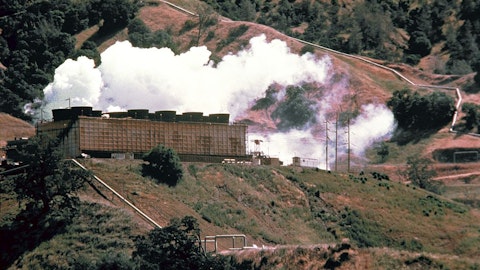Baker Hughes Company (NASDAQ:BKR) Q4 2023 Earnings Call Transcript January 24, 2024
Baker Hughes Company isn’t one of the 30 most popular stocks among hedge funds at the end of the third quarter (see the details here).
Operator: Good day, ladies and gentlemen and welcome to the Baker Hughes Company Fourth Quarter 2023 Earnings Call. [Operator Instructions] As a reminder, this conference call is being recorded. I would now like to introduce your host for today’s conference, Mr. Chase Mulvehill, Vice President of Investor Relations. Sir, you may begin.
Chase Mulvehill: Thank you. Good morning, everyone and welcome to Baker Hughes fourth quarter and full year 2023 earnings conference call. Here with me are our Chairman and CEO, Lorenzo Simonelli; and our CFO, Nancy Buese. The earnings release we issued yesterday evening can be found on our website at bakerhughes.com. We will also be using a presentation with our prepared remarks during this webcast, which can also be found on our investor website. As a reminder, during the course of this conference call, we will provide forward-looking statements. These statements are not guarantees of future performance and involve a number of risks and assumptions. Please review our SEC filings and website for factors that could cause actual results to differ materially. Reconciliations of operating income and other GAAP to non-GAAP measures can be found in our earnings release. With that, I’ll turn the call over to Lorenzo.
Lorenzo Simonelli: Thank you, Chase. Good morning, everyone and thanks for joining us. 2023 proved to be a pivotal year for Baker Hughes as we continue our journey to reshape the company. We successfully removed $150 million of costs, realigned our IET business and recently launched actions to further streamline our OFSE business. Our strategy to transform the way we operate is working. Turning to Slide 4. In 2023, we set records for all primary financial metrics, including orders, revenue, EBITDA, EPS, free cash flow and most importantly, returns. Adjusted EBITDA was up 26% year-over-year, a third consecutive year of double-digit increases and exceeding prior cycle peak levels by 25%. Adjusted diluted earnings per share was $1.60, 76% above 2022 levels.
Free cash flow increased 83% year-over-year to just over $2 billion. Total company orders increased 14% year-over-year as IET orders of $14.2 billion grew 12% when compared to last year’s record orders and marked the third consecutive year of double-digit growth. New Energy orders totaled $750 million, up 45% year-over-year. SSPS orders increased by 27% to $3.9 billion, the largest order year since 2014. These record results highlight strong market tailwinds across both segments and the significant operational improvements the company has accomplished since 2022. Clearly, we are pleased with the progress demonstrated in 2023 and excited about where the company is headed in 2024 and beyond. Turning to Slide 5. Fourth quarter adjusted EBITDA of $1.09 billion came in above the midpoint of our guidance range due to the continued operational improvement and full realization of the $150 million of cost out.
Free cash flow of $633 million exceeded expectations and resulted in full year free cash flow conversion of 54%. IET orders remained strong, exceeding $3 billion for the fifth consecutive quarter. In addition, we were awarded more than $1 billion of CSA commitments. In OFSE, we continue to demonstrate solid margin improvement during the quarter, with segment EBITDA margin increasing to 17.9% as OFS EBITDA margins now exceed 20%, both record margins. Turning to the macro on Slide 6. Oil prices have weakened considerably since peaking in late September. Ultimately, weaker-than-anticipated oil demand coupled with robust production growth led to an unexpected inventory build into year end. However, prices still remain at levels that are favorable for growth across our core OFSE markets.
For 2024, demand growth remains the biggest unknown in the face of global economic uncertainty and heightened geopolitical risk. On the supply side, the biggest risk factor is non-OPEC supply outpacing demand, possibly requiring OPEC+ to maintain the current level of cuts through the end of 2024. The volatility in commodity prices experienced during the fourth quarter and so far in 2024 will likely have some influence on upstream development plans. Accordingly, we now see international D&C spend growth decelerating into the high single-digit range this year, which is down slightly from our prior expectations for low double-digit growth. Nevertheless, the international cycle remains healthy and we see no deviation from the long-term development plans set in place amongst some of the world’s largest NOCs. The offshore cycle is maintaining the momentum built over the past couple of years and we have good visibility on the development pipeline, which is expected to support strong activity levels over the next several years.
In North America, activity continues to lag and we are now anticipating no meaningful recovery in activity during the first half of the year. On our last quarterly call, we expected 2024 North American D&C spend to be flattish, but now expect spending down in low to mid single-digits driven by mid single-digit declines in U.S. land. The combination of a volatile commodity price environment, sector consolidation and the inherent elasticity of shale versus conventional developments are all factors contributing to the slower ramp up in activity. In OFSE, we secured two significant multiyear integrated services contracts with a Latin American operator for drilling, completion and plug and abandonment services, highlighting the customers’ confidence in Baker Hughes’ diverse technology and service offering.
In the offshore market, we were awarded additional subsea trees during the quarter, bringing our total number of subsea tree awards in 2023 to 60. Turning to LNG on Slide 7. Despite the recent weakness in LNG prices, we believe the long-term outlook for the global LNG market remains solid. In fact, LNG prices remain at relatively strong levels compared to historical averages. For example, 2023 European and Asian gas prices averaged about 20% above the 10-year average. In the fourth quarter, global LNG demand was up approximately 4% year-over-year. For the full year, global LNG demand reached record levels of 405 MTPA, up 2% compared to 2022 despite softer than anticipated gas demand in Europe. LNG demand in Europe was around 115 MTPA in line with 2022 levels.
Demand in China was 71 MTPA, up 10% year-over-year. With estimated global nameplate capacity of 491 MTPA last year, effective utilization averaged 86%, which represents a tight LNG market. Looking into 2024, we forecast LNG demand to increase by 2% which should result in utilization rates remaining at strong levels as we forecast just 15 MTPA of nameplate capacity coming online this year. Looking out to 2025 and 2026, we see a similar trend of supply growth being balanced by demand growth, which should keep global LNG markets at good utilization levels. With energy markets, including LNG, still fundamentally tight, global coal demand set another record last year, increasing 1.4% year-over-year to 8.5 billion tons. We think this recent growth in coal demand provides additional long-term growth opportunities for LNG, where we see cleaner burning natural gas replacing high emission coal in the energy mix across many Asian countries, where coal is still the predominant energy source for electricity.
During the fourth quarter, we were pleased to be awarded by ADNOC gas on behalf of ADNOC to electric liquefaction systems for the 9.6 MTPA Ruwais LNG project in the United Arab Emirates. The LNG trains will be driven by Baker Hughes’ 75-megawatt brush electric motor technology and will feature our state-of-the-art compressor technology making Ruwais LNG one of the first all-electric LNG projects in the Middle East. In 2023, we were extremely pleased to book almost 80 MTPA of LNG orders, which outpaced FIDs of 57 MTPA. This variance was the result of the timing difference between orders and FIDs, which has been accentuated by the tightening LNG equipment market. The outlook for FIDs over the next few years remains strong and we see projects progressing across all markets.
For 2024 specifically, we expect LNG FIDs of around 65 MTPA. However, it is important to note this includes a couple of major LNG orders that were booked during 2023. As we look out to 2025 and 2026, we could see between 30 to 60 MTPA of FIDs annually bringing total potential LNG FIDs to 125 MTPA and 185 MTPA through 2026. Based on existing capacity, projects under construction and future FIDs in the pipeline, we have line of sight for global LNG installed capacity to reach 800 MTPA by the end of 2030, representing an almost 75% increase in nameplate capacity from 2022 levels. This provides good visibility for significant near-term growth in Gas Tech equipment, where we have the broadest set of LNG solutions to suit customer needs, including our modular, stick build, onshore, offshore, floating and small-scale LNG offerings.
In addition, this expansion in our LNG installed base will provide long-term structural growth for our Gas Tech services. Turning now to Slide 8. On the New Energy front, we have seen a number of developments over the past quarter. At COP28, which brought together 154 heads of state and other government officials and was well represented by Baker Hughes, I was particularly pleased to see the increased representation and participation from energy companies. Key commitments from the conference include doubling the global average annual rate of energy efficiency improvements by 2030, net-zero methane emissions and no routine flaring by 2030, endorsement for a global hydrogen certification standard and accelerating efforts towards the phase down of unabated coal power.
We also continue to see progress on the policy and permitting front in the United States that should help advance emissions reductions progress. We are pleased with the U.S.’ final ruling on the methane standards that should prevent an estimated 58 million tons of methane emissions from 2024 to 2038, according to the EPA. Additionally, the state of Louisiana being granted primacy on Class 6 well permitting should help to reduce CCUS project bottlenecks in that region of the United States. In the area of hydrogen, the U.S. Treasury provided clarity on the 45V hydrogen tax credit, which could impact the pace of green hydrogen development. We are hopeful that a pragmatic resolution will be reached that actually encourages rather than inhibits new investments in this critical industry that will play a vital role in decarbonizing hard-to-abate sectors.
As we have stated previously, the energy transition will likely be more challenging and take longer than many expect. This is why we, at Baker Hughes, are pursuing an all-of-the-above strategy, where our technologies and capabilities have a key role to play in decarbonizing the planet irrespective of the fuel source. It is important to note the pace of the transition will not impact the ultimate size of the new energy market opportunity. As an illustration, the IEA has sized the annual clean energy investment at $4.5 trillion by the early 2030s and $4.7 trillion by 2050 under their net zero scenario. In comparison, investment in fossil fuels totaled just under $1 trillion last year. Turning to Slide 9. We are focused on executing our strategy over our free time horizons.
Over the first horizon, we are focused on unlocking the full potential of Baker Hughes, successfully transforming our business and simplifying the way we work. We are committed to developing and commercializing our New Energy portfolio while also evolving our digital offerings across both OFSE and IET. These strategic investments, along with better penetration across various underserved energy and industrial markets will be the underpinning for driving peer-leading growth across our next two time horizons. While our activities in LNG and New Energy have been the focus for investors in recent years, I’d like to take this opportunity to shine a spotlight on parts of the broader IET portfolio. In Gas Tech, almost 50% of our equipment business is focused on serving customers outside of LNG.
Our turbomachinery equipment, generators, motors and pumps have applications across multiple end markets, including upstream, midstream, refining, petrochemical and various industrial end markets. These segments have demonstrated exceptional growth since 2020, increasing by more than 50% and we have good visibility on a number of growth opportunities in the coming year. Take the FPSO markets, for example, we have booked more than $1 billion of awards over the past 2 years and expect the market could see a further 7 to 9 FPSOs take FID each year out to the latter part of this decade. We are also seeing a lot of potential opportunities in onshore gas processing and pipelines as natural gas becomes an important aspect of the energy mix around the world, particularly in places like the Middle East and Southeast Asia.
The diversity of our end markets and the opportunity set is not confined to equipment. In Gas Tech Services, over 50% of our revenue has been generated from our transactional and upgrade services, which focus on maintaining our rotating equipment utilized in upstream, midstream, refining and petrochemical sectors. Like LNG, which accounts for less than 40% of the Gas Tech Services revenue, these non-LNG markets also have significant growth opportunities as our installed base expands significantly. Our industrial tech portfolio provides additional diversity into industrial markets like aerospace, automotive, steel and electronics. In Industrial Solutions, we leverage our digital technology to monitor and maintain critical equipment. We have a significant opportunity to extend this service beyond our critical equipment to the balance of plant.
In industrial products, we are focused on increasing market penetration in high-margin niche sectors. Finally and most importantly, we are able to leverage core technologies like compressors, turbo expanders and turbines across CTS’ 5 targeted new energy markets. These are CCUS, hydrogen, geothermal, clean power and emissions management, providing additional long-term growth for IET. As you can see, we have a differentiated portfolio of technologies within IET that provides Baker Hughes a unique opportunity to grow well beyond LNG. Before turning it over to Nancy, I would like to speak at a high level about our 2024 outlook. In OFSE, we expect solid revenue growth led by international, with a year of strong incremental margins as we continue to focus on reshaping the OFSE cost structure in pursuit of 20% margins in 2025.

In IET, conversion of our record Gas Tech Equipment RPO will drive robust IET revenue growth, with margins improving despite increasing mix headwinds and putting us on a path toward our 20% margin target in 2026. With that, I’ll turn the call over to Nancy.
Nancy Buese: Thanks, Lorenzo. I will begin on Slide 11 with an overview of our consolidated results and then briefly talk to segment details before outlining our first quarter and full year 2024 outlook. We were very pleased with our fourth quarter and full year results. We made outstanding progress on all fronts during 2023. We booked another year of record orders in IET, capitalized on market tailwinds to deliver robust revenue growth across both segments, realized the full benefit of our $150 million cost out program, and continue to transform how we operate. For the fourth quarter, adjusted EBITDA of $1.09 billion came in above the midpoint of our guidance range, which was due to stronger margin performance across both segments.
For the year, EBITDA came in at the upper end of our original $3.6 billion to $3.8 billion guidance range. Fourth quarter GAAP operating income was $651 million during the quarter. Adjusted operating income was $816 million. GAAP diluted earnings per share were $0.43. Excluding adjusting items, earnings per share were $0.51, which resulted in 2023 adjusted EPS of $1.60, a new record. Total company orders of $6.9 billion during the quarter maintained strong momentum, highlighted by continued strength in IET orders. For the year, IET orders totaled $14.2 billion, which sets another record. SSPS full year orders were a robust $3.9 billion, which as Lorenzo mentioned, marks our largest order intake for that business since 2014. Thanks to the sustained strength in orders, IET RPO of $29.9 billion ended the quarter at yet another record level, while OFSE-RPO remained at a healthy $3.5 billion, up 37% year-over-year.
These RPO levels provide exceptional revenue and earnings visibility over the coming years. Free cash flow outperformed our expectations, coming in at $633 million. For the full year, we generated over $2 billion of free cash flow, resulting in a conversion rate of 54% from adjusted EBITDA, which was above the high end of our expected range. In 2024, we are targeting free cash flow conversion of 45% to 50% and expect 50%-plus conversion rates through Horizons 2 and 3. Turning to Slide 12. Our balance sheet remains strong as we ended the fourth quarter with cash of $2.65 billion, net debt to trailing 12-month adjusted EBITDA ratio of 0.9x and liquidity of over $5.5 billion. During the fourth quarter, we extended our $3 billion revolving credit facility by 4 years, which now has a maturity of November 2028 and we also used available cash to pay down $650 million of senior notes.
Turning to capital allocation on Slide 13. In 2023, we returned more than $1.3 billion to shareholders equivalent to 65% of free cash flow. This included almost $800 million of dividends, where we have increased the quarterly dividend twice over the past five quarters. In addition, we repurchased $538 million of Baker Hughes shares in 2023, including $321 million during the fourth quarter. We are committed to returning 60% to 80% of free cash flow to investors and have a strong track record. Since the company was formed in 2017, we’ve now returned $10 billion to shareholders through dividends and buybacks. We plan to grow our dividend with increases driven by the structural earnings power and growth of the company. We will continue to utilize buybacks to reach our 60% to 80% target and we will remain opportunistic on buybacks within this range.
Now I will walk you through the business segment results in more detail and provide our 2024 outlook. Starting with oilfield services and equipment on Slide 14. The segment performed slightly above expectations as OFS margins exceeded the 20% level despite the softer U.S. land market where rig activity fell 4% during the quarter. SSPS orders of $654 million contributed to the highest order year since 2014 with the offshore market expected to remain strong, we expect SSPS orders to persist at healthy levels in 2024 and beyond. OFS revenue in the quarter was $3.95 billion, up 11% year-over-year. Excluding SSPS, international revenue was up 2% sequentially as seasonal declines in Europe were more than offset by strength in Latin America and Sub-Saharan Africa.
Excluding SSPS, North America revenue was down 3% sequentially as North America land declined during the quarter. OFSE EBITDA in the quarter was $709 million, up 6% sequentially and up 16% year-over-year, while also slightly above our guidance midpoint of $705 million. OFSE EBITDA margin rate was 17.9%, increasing 99 basis points sequentially and 79 basis points year-over-year. SSPS margins significantly improved year-over-year increasing by 300 basis points to just over 8%, driven by improved execution and commercial success. Now turning to Industrial and Energy Technology on Slide 15. This segment also performed above expectations during the quarter due to a better-than-expected Gas Tech margin. IET orders were $3 billion, included more than $800 million of LNG equipment, bringing full year LNG equipment orders to approximately $5.6 billion.
Orders in CTS, which now comprises IET’s New Energy business increased to $123 million in the fourth quarter with about 80% of these orders representing projects across the clean power and emissions management markets. IET RPO ended the quarter at $29.9 billion, up 4% sequentially. Gas Tech Equipment RPO was $12.1 billion. Gas Tech Services RPO was $14.8 billion and included more than $1.1 billion of newly signed CSA contracts. Gas Tech Equipment book-to-bill was 1.1x, the tenth consecutive quarter above one. Turning to Slide 16. IET revenue for the quarter was $2.9 billion, up 24% versus the prior year, led by Gas Tech Equipment growth that was up more than 40% year-over-year, driven by execution of project backlog. IET EBITDA was $463 million, up 8% year-over-year and coming in above our guidance midpoint of $460 million.
EBITDA margin was 16.1% down 233 basis points year-over-year, a solid improvement in Gas Tech equipment margin was offset by mix and higher R&D spend related to our new energy investments. For 2023, IET R&D spending increased by approximately $70 million as we continue to advance our New Energy investments as well as investing in other IET technology upgrades. Turning to Slide 17. Before detailing our outlook, I’d like to provide an update on our business transformation activities and the path that lies ahead in unlocking the full potential of Baker Hughes. Over the course of the past 18 months, the business has undertaken significant structural changes that delivered over $150 million of annualized cost synergies, providing sustainable benefits across the organization.
However, there is still more to do as we continue our transformation journey. Our focus is on operational excellence and continuous improvement all that we do. Early this year, we launched actions in OFSE to remove duplication and drive more cost efficiency across the business. These measures resulted in additional restructuring charges during the fourth quarter with these changes being executed during the first half of 2024. These charges are almost entirely related to severance costs. It’s important to note that these discrete OFSE actions will drive margin upside into the back half of this year and put the segment on a clear path to achieve 20% margins in 2025. As we continue our transformation work in 2024, we continue to focus on eliminating duplication, remaining focused on execution and listening to our customers while ensuring the company is set up for success in the back half of this decade.
In 2023, we laid the groundwork for improved execution, accountability and transparency. We will draw on those foundational aspects to evolve Baker Hughes. We’ve begun the work of synchronizing many diverse systems and working towards efficient and streamlined processes and reporting. These efforts will allow us efficiency gains, improve data, all oriented towards the goal of structural margin improvements. A further part of our transformation journey is centered around our approach to customers and meeting their needs. As we’ve highlighted, customers are increasingly looking for integrated solutions as they reduce the emissions footprint of their operations. It is critical that our OFSE and IET commercial teams collaborate and respond to these customer demands.
Driven by this developing customer trend, we see an opportunity for greater collaboration across the Baker Hughes organization, which will be a vitally important factor in unlocking the full commercial potential of our unique and differentiated service and technology portfolio. Next, I’d like to update you on our outlook for the two business segments, which is detailed on Slide 18. Overall, the outlook remains strong for both OFSE and IET with tailwinds expected to persist across each business in spite of macro uncertainty. This will be complemented by continued operational enhancements, driving sustained improvement in backlog execution and margin upside as we pursue our 20% margin target across both segments. For Baker Hughes, we expect first quarter revenue to be between $6.1 billion and $6.6 billion and EBITDA between $880 million and $960 million.
For IET, we expect first quarter results to reflect seasonal declines in both Gas Tech and Industrial Tech businesses. However, due to improved linearity, we expect Gas Tech sequential declines to be less pronounced than prior years. Overall, for IET, we expect first quarter revenue between $2.4 billion and $2.65 billion and EBITDA between $340 million and $380 million. The major factors driving this range will be the pace of backlog conversion in Gas Tech Equipment and the impact of any aeroderivative supply chain tightness in Gas Tech. For OFSE, we expect first quarter results to reflect the typical seasonal decline in international revenues as well as a slow start across U.S. land markets. We therefore expect first quarter OFSE revenue between $3.7 billion and $3.95 billion and EBITDA between $630 million and $670 million.
Factors driving this range include the pacing of 2024 E&P budgets, SSPS backlog conversion, realization of further cost-out initiatives and winter weather in the Northern Hemisphere. Turning to our full year outlook. For the full year 2024, we expect Baker Hughes revenue to be between $26.5 million and $28.5 billion and EBITDA between $4.1 billion and $4.5 billion. In addition, we expect total company New Energy orders of $800 million to $1 billion, which would amount to more than tripling of New Energy orders since 2021. We expect IET orders to remain at robust levels this year, anticipating a range between $11.5 billion to $13.5 billion, driven by strong momentum across all aspects of the IET portfolio. Importantly, we expect a noticeable increase in non-LNG Gas Tech Equipment orders.
As a result of this continued momentum and exceptional orders performance over the last 2 years, we expect full year IET revenue between $10.75 billion and $11.75 billion and EBITDA between $1.65 billion and $1.85 billion. For OFSE, we forecast full year revenue between and $15.75 billion and $16.75 billion and EBITDA between $2.8 billion and $3 billion as we expect softness in North America land to more than offset continued strength across international markets. In summary, 2023 was a strong year of execution for Baker Hughes, where we delivered results near the high end of our original guidance range and set records for all our primary financial metrics. In 2024, we expect double-digit EBITDA growth for the fourth consecutive year as we remain focused on execution, driving further operational improvements and capitalizing on market tailwinds with our unique solutions and equipment portfolio.
Lastly, we are intensely focused on achieving the guidance set for 2024 and our 20% EBITDA margin targets for OFSE in 2025 and IET in 2026 and while 20% segment margins are important intermediate goals, we will continue to take transformative actions to exceed these levels. Overall, we are proud of the progress demonstrated by our 2023 results and remain very excited about the future of Baker Hughes. I’ll turn the call back over to Lorenzo.
Lorenzo Simonelli: Thank you, Nancy. As you can see from our strong 2023 results and the exceptionally strong margin improvement illustrated on Slide 20. Baker Hughes is on its way to becoming a leaner and more efficient energy technology company. We continue to carefully execute our plan to drive margins meaningfully higher. Put simply, we remain relentless in transforming the way we operate. We also have a unique technology portfolio that will drive growth across all three of our horizons irrespective of the pace of the energy transition. In addition, our versatile OFSE and IET portfolios provide significant growth opportunities across underserved end markets. It’s this broad-based portfolio that underpinned our 17% EBITDA compounded annual growth rate from 2020 through 2023.
Given our balanced portfolio, untapped market opportunities and overhaul cost structure, Baker Hughes is becoming less cyclical in nature and therefore, should generate more durable earnings and free cash flow across cycles. Finally, while on this journey, we remain committed to our employees, customers and shareholders as we continue to push Baker Hughes forward. With that, I’ll turn the call back over to Chase.
Chase Mulvehill: Thanks, Lorenzo. Operator, let’s open the call for questions.
See also 20 Safest Countries for US Travelers in the World and Best DUI Lawyers in Each of 30 Biggest Cities in the US.
Q&A Session
Follow Baker Michael Corp (NYSEMKT:BKR)
Follow Baker Michael Corp (NYSEMKT:BKR)
Operator: Thank you. [Operator Instructions] Our first question comes from James West with Evercore ISI. You may proceed.
James West: Hey, good morning, Lorenzo and Nancy.
Lorenzo Simonelli: Hi, James.
James West: So Lorenzo, there is a lot of versatility in the IET portfolio that you guys have put together here and you talked a bunch about it in prepared remarks, but I’m curious to know which of the end markets today do you see the biggest opportunities for growth?
Lorenzo Simonelli: Yes, definitely, James. And we’ve said it before, and we wanted to state it more clearly. Our IET business has a very expansive portfolio of equipment and solutions, which really play across many different end markets, including upstream, midstream, refining, petrochemical and a number of industrial end markets, aerospace, automotive. And we think that’s been underappreciated to date. And largely because there is been a large focus, which quite reasonably on LNG and New Energy, and we’re very proud of our LNG business. We’ve worked hard over the years to build it, and we’ve got differentiated solutions. And we’re going to be committed to continue being the market leader for liquefaction solutions across all of the LNG markets.
And we think that LNG is still very positive with LNG awards over the next 2 to 3 years and also reaching the market installed capacity of 800 MTPA by 2030. But our Gas Tech Equipment is also more than that. We’ve demonstrated exceptional growth since 2020 increasing by more than 50% in other areas, and we’ve got good visibility on a number of growth opportunities in the coming years. A couple of examples, as you look at onshore offshore production OOP, we’ve got a leadership position in FPSOs, and we see another 7 to 9 FPSOs over the course of the next few years. In onshore production, we’re seeing the emergence of a number of opportunities associated with pipeline and the processing of gas in particular, as that continues to grow in places like the Middle East and also exposure to petrochemicals, which is ultimately anticipated to continue to grow and we’ve got the new Nova class of turbines, compressors, valves, pumps, gears, digital solutions.
So put all in all, it boils down to an exceptionally versatile IET portfolio that provides us significant growth opportunities as we serve many of the strengthening underserved markets in the coming years.
James West: Great to hear. I think there is huge opportunities there. And then maybe a follow-up for me on the New Energy’s business. Clearly, orders ramping significantly $400 million to $750 million and I heard Nancy’s guidance for this year as seeing a continued growth there. Which parts of the New Energy’s portfolio, kind of similar question to the IET broadly, but do you see the most potential near-term growth? Where is the biggest demand today?
Lorenzo Simonelli: Definitely. We’ve been very pleased with the progress of New Energy orders and you saw last year that we continue to take up also our guidance on New Energy. And as you correctly stated, we’ve given guidance this year relative to the $800 million and also the $1 billion. And we really think that this growth continues going forward. The markets are growing, maturing across both IET and OFSE portfolio technologies. And when you look at it, it really is a sequence of carbon capture technologies that we have in our portfolio, Compact Carbon Capture, Mosaic, as you look at direct air capture, you look at the partnership we have with NET Power supplying turbo expanders. And also, as you look at hydrogen and you’ve seen the growing emphasis on hydrogen and hard-to-abate areas but also geothermal and looking at emissions management and deflaring.
And I think again, as a consequence of some of the discussions at COP 28, there is a clear move towards accelerating some of these as we continue to move forward. And our total addressable market, we’ve mentioned it before, for New Energy in 2030 is between $60 billion to $70 billion across the five major markets that we serve. And we believe we can book $6 billion to $7 billion of New Energy orders by 2030. So again, it’s something that we see as a growing area of the business and feel confident in that $6 billion to $7 billion of New Energy orders in 2030.
James West: Perfect. Thank you, Lorenzo.
Lorenzo Simonelli: Thanks, James.
Operator: Thank you. [Operator Instructions] Our next question comes from Luke Lemoine with Piper Sandler. You may proceed.
Luke Lemoine: Hi. Good morning Lorenzo and Nancy. Your ‘24 quantitative outlook is pretty clear, and you gave us the international North America OFSE growth rates as well. But I want to see if you could just loosely walk us through some of the qualitative aspects of the ‘24 OFSE margin increase, along with the drivers of the increase in IET revs and margins.
Nancy Buese: Yes. So, thanks Luke for the question. Yes. We have been really pleased with our performance in ‘23. We generated record EBITDA at levels last year that were about 25% before – above prior cycle peaks. On our consolidated updated EBITDA margins for ‘23, we averaged about 200 bps above the ‘18 and ‘19 levels. So, at the midpoint of our guidance, this implies another year of strong EBITDA in the mid-teens range, which would mark for us the fourth consecutive year of double-digit growth. And then when we think about 2024, we are going to show another material step-up in margins for the total company, up about 100 basis points for overall company results. And then to your question about the segments, they both demonstrate margin improvement with potential upside as we continue to execute further cost optimization initiatives across the organization.





